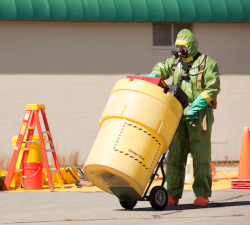Training
Introduction
Anyone who enters a hazardous waste site must be able to recognize and understand the potential hazards to health and safety associated with the activities of that site.
They must be thoroughly familiar with programs and procedures contained in the Site Safety Plan and must be trained to work safely in contaminated areas.
Visitors to a site must receive adequate training on hazard recognition and on the site's Standard Operating Procedures to enable them to conduct their visit safely.
The objectives of training programs for employees involved in hazardous waste site activities are:
- To make workers aware of the potential hazards they may encounter.
- To provide the knowledge and skills necessary to perform the work with minimal risk to worker health and safety.
- To make workers aware of the purpose and limitations of safety equipment.
- To ensure workers can safely avoid or escape from emergencies.
Three Training Components
OSHA 29 CFR 1910.120(e)(3)(i) requires three components of HAZWOPER training. The training should be consistent with the worker's job function and responsibilities. The training must include the following knowledge, skills, and experience components:
- Knowledge: The initial 40-hour training must be conducted off the site either as a computer (online) course or in the classroom setting.
- Skills: The skills-level training is conducted off the site by a competent and qualified person, and provides hands-on practice drills in the learning environment to gain the skills needed to perform on-site HAZWOPER activities.
- Experience: The responsibility for providing this three-day (24-hour) onsite training component falls on the employer. OSHA requires that workers complete at least three days of actual field experience under the direct supervision of a trained, experienced supervisor before they are considered fully trained.
Below is an example of the curriculum for the three-day field-experience training component.
Overview: The HAZWOPER three-day onsite training is a practical, hands-on experience that must follow the off-site 40-hour initial instruction and skills training.
Responsibility for Conducting the HAZWOPER Three-Day Onsite Training:
Key Roles:
- Employer: Must arrange and ensure that the three-day field experience is completed. The employer is responsible for the safety and effectiveness of the training process.
- Qualified Trainer or Supervisor: Must be a person who has already completed the 40-hour HAZWOPER training and has sufficient knowledge, training, and experience in hazardous waste operations. This individual will directly supervise and evaluate the trainees during the field experience.
Purpose of Supervised Training: This supervised experience is critical for evaluating whether workers can apply safety principles and practices in real hazardous situations. It allows for observation, correction, and reinforcement of safe work habits.
Summary: The employer is ultimately responsible for organizing and overseeing the three-day onsite training, which must be led by a qualified, experienced supervisor to meet OSHA's compliance requirements.
Key Components of the Onsite Training:
-
Personal Protective Equipment (PPE) Usage
- Selection, donning, and doffing of PPE
- Understanding limitations and maintenance of PPE
-
Decontamination Procedures
- Setting up decontamination zones
- Effective decontamination methods for personnel and equipment
-
Hazard Recognition and Evaluation
- Identification of chemical, biological, and physical hazards
- Risk assessment and control measures
-
Emergency Response Planning
- Development of emergency response plans
- Coordination with emergency teams using the Incident Command System (ICS)
-
Site Control and Safety Measures
- Establishment of exclusion, contamination reduction, and support zones
- Implementation of safety protocols
-
Monitoring and Sampling Techniques
- Use of instruments to detect hazardous substances
- Sample collection procedures
-
Waste Handling and Disposal
- Proper procedures for hazardous waste handling and storage
- Compliance with disposal regulations
-
Medical Surveillance and Recordkeeping
- Health monitoring and exposure assessments
- Accurate documentation as required by OSHA
All training information should be presented in clear, concise language. Particularly important information, such as the Standard Operating Procedures, should be provided in writing. A variety of teaching aids (i.e., films, tapes, slides, etc.) should be used, and lecture sessions should be interspersed with class participation and hands-on training. All employees should also complete refresher training, at least annually, to reemphasize the initial training and to update workers on any new policies or procedures.
Knowledge Check Choose the best answer for the question.
5-1. An objective of a safety training program for employees involved in hazardous waste site activities is?
You forgot to answer the question!

